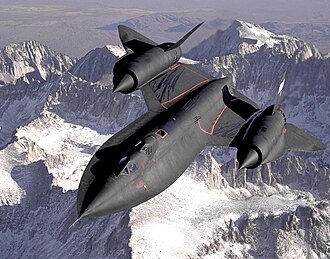Lockheed SR-71 Blackbird
The SR-71 Blackbird is a supersonic reconnaissance aircraft. It was built by Lockheed's "Skunk Works" in the 1960s for the United States Air Force (USAF). In other words, it was a spy plane.
| SR-71 "Blackbird" | |
|---|---|
| An SR-71B trainer over the Sierra Nevada Mountains of California in 1994. The raised second cockpit is for the instructor. | |
| Role | Strategic reconnaissance aircraft |
| National origin | United States |
| Manufacturer | Lockheed, Skunk Works division |
| Designer | Clarence "Kelly" Johnson |
| First flight | 22 December 1964 |
| Introduction | January 1966 |
| Retired | 1998 (USAF), 1999 (NASA) |
| Status | Retired |
| Primary users | United States Air Force NASA |
| Number built | 32 |
| Unit cost | $34 million[1] |
| Developed from | Lockheed A-12 |
Design
The Blackbird was designed to fly at more than Mach 3 – three times the speed of sound. This meant it would become very hot during flight. To help with this, most of the aircraft was made of titanium. Radar absorbing material was also used to make the aircraft more difficult to detect.
SR-71 Blackbird used a special fuel called JP-7. Before the flight, the fuel tanks used to leak. This is because at ground altitude the tolerances (distance between parts of the fuel tank) were larger than at the plane's cruising altitude. Once in the air, because of the speed and air resistance, the parts became very hot. Because of this heat, the distance between the parts shrank stopping the loss of fuel.[2]
The aircraft also had cameras and radars fitted to take photographs of targets.
History
The first Blackbird flight happened on December 22, 1964 in Palmdale, California. In January 1966, the first aircraft entered service with the USAF. No aircraft were lost in war but one crashed in an accident in 1969. Only 32 aircraft were built. Its final flight was on March 6, 1990, Blackbird S/N 61-7972. The SR-71 program was retired from service in 1998.
Records
The aircraft flew at an altitude of over 80,000 feet (24,000 m) and at speeds over 2,190 miles per hour (3,520 km/h). It held the world record for the jet-powered flight, flying at Mach 3.2.[3] The record was broken in March 2004 by NASA's X-43A aircraft.
Specifications (SR-71A)
Data from Lockheed SR-71 Blackbird[4]
General characteristics
- Crew: 2; Pilot and reconnaissance systems officer (RSO)
- Length: 107 ft 5 in (32.74 m)
- Wingspan: 55 ft 7 in (16.94 m)
- Height: 18 ft 6 in (5.64 m)
- Wheel track: 16 ft 8 in (5 m)
- Wheelbase: 37 ft 10 in (12 m)
- Wing area: 1,800 sq ft (170 m2)
- Aspect ratio: 1.7
- Empty weight: 67,500 lb (30,617 kg)
- Gross weight: 152,000 lb (68,946 kg)
- Max takeoff weight: 172,000 lb (78,018 kg)
- Fuel capacity: 12,219.2 US gal (10,174.6 imp gal; 46,255 L) in 6 tank groups (9 tanks)
- Powerplant: 2 × Pratt & Whitney J58 (JTllD-20J or JTllD-20K) continuous-bleed afterburning turbojets, 25,000 lbf (110 kN) thrust each
- JTllD-20J 32,500 lbf (144.57 kN) wet (fixed inlet guidevanes)
- JTllD-20K 34,000 lbf (151.24 kN) wet (2-position inlet guidevanes)
Performance
- Maximum speed: 1,910 kn (2,198 mph; 3,537 km/h) at 80,000 ft (24,000 m)
- Maximum speed: Mach 3.32[N 1]
- Ferry range: 2,824 nmi (3,250 mi; 5,230 km)
- Service ceiling: 85,000 ft (26,000 m)
- Rate of climb: 11,820 ft/min (60.0 m/s)
- Wing loading: 84 lb/sq ft (410 kg/m2)
- Thrust/weight: 0.44
Avionics
3,500 lb (1,588 kg) of mission equipment
- Itek KA-102A 36–48 in (910–1,220 mm) camera
- SIGINT and ELINT equipment in the following compartments
- A - nose radar
- D - right chine bay
- E - electronics bay
- K - left forward mission bay
- L - right forward mission bay
- M - left forward mission bay
- N - right forward mission bay
- P - left aft mission bay
- Q - right aft mission bay
- R - radio equipment bay
- S - left aft mission bay
- T - right aft mission bay
Lockheed SR-71 Blackbird Media
SR-71 Blackbird assembly line at Skunk Works
Detail of SR-71A at the Museum of Aviation, Robins AFB showing red lined no-step areas. Not shown on this museum exhibit is the additional NO STEP wording on operational aircraft which showed to which side of the line the warning was applicable.
Water vapor is condensed by the low-pressure vortices generated by the chines outboard of each engine inlet.
An SR-71 refueling from a KC-135Q Stratotanker during a flight in 1983.
An SR-71 refueling from a KC-10 Extender. KC-10s were added in the mid-1980s as additional tankers.[6]
SR-71 pilot Brian Shul in full flight suit
Notes
References
- ↑ Edwards, Owen (July 2009). "The Ultimate Spy Plane". Smithsonian Magazine. Retrieved 2017-11-27.
The 32 Blackbirds cost an average of $34 million each.
- ↑ sr-71.org
- ↑ "Q&A: Nasa's jet speed record". BBC News. 2004-11-17. Retrieved 2009-09-02.
- ↑ Pace 2004, p. 110.
- ↑ Graham 2002, pp. 93, 223.
- ↑ Graham 2008.










